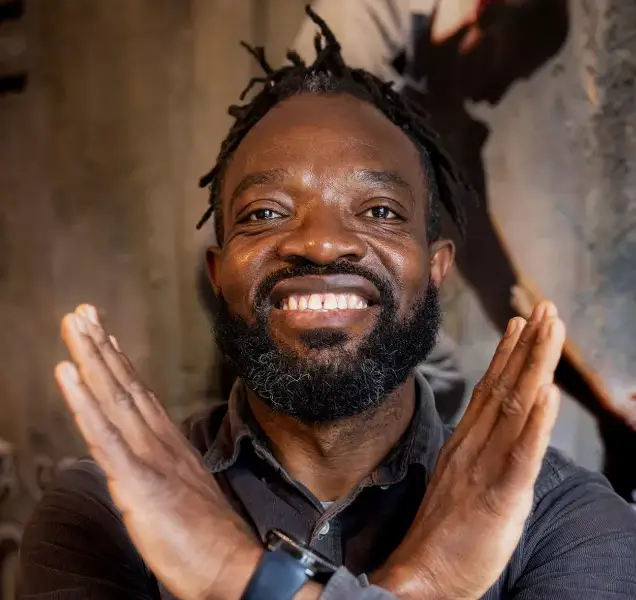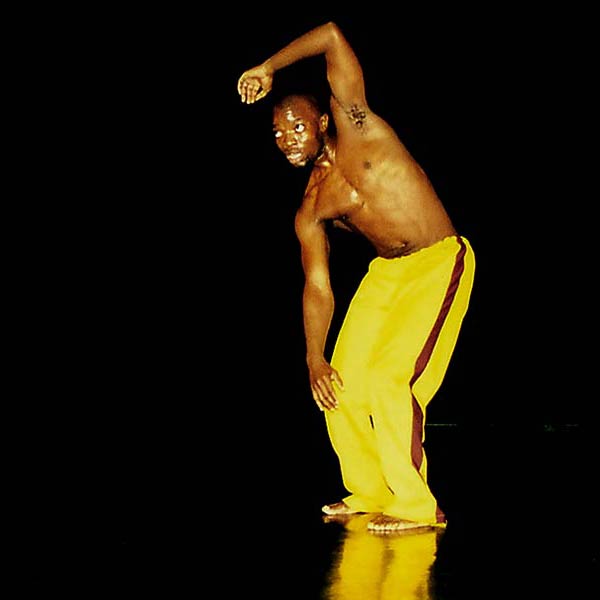Bouba Landrille Tchouda est un danseur intense et un chorégraphe réfléchi. Il aborde la danse sous une multitude de facette et mène un travail puissant qui mêle le hip-hop, la capoeira et la danse contemporaine. Son parcours métissé, fait de rencontres originales, alimente son exploration des infinies possibilités du langage de la danse, cherchant à en repousser ses limites, à dépasser les barrières de genres. Les tournées nationales et internationales qu’il effectue lui permettent aujourd’hui de se positionner en tant que chorégraphe au-delà de nos frontières.
L’énergie de la passion
« Exprimer en chair et en os, regarder et penser le monde avec le corps, rendre visible une partie de soi, mettre sa vie en mouvement, confronter nos interrogations, alimenter un dialogue intime entre l’esprit et le geste, réunir l’émotion et l’intelligence. »
« Ma danse se veut une danse pour dire, en toute modestie, que nous pouvons avec elle contribuer à changer les choses, apporter un peu de poésie, alléger le quotidien. Elle est une vibration qui me meut de l’intérieur pour aller vers les uns et les autres. Danser m’a permis de franchir ce qui me paraissait infranchissable »

Les débuts
Comme pour beaucoup de danseurs hip-hop, son apprentissage démarre de manière autodidacte au milieu des années 80. Curieux, il part étudier la capoeira à Salvador de Bahia et à Fortaleza dans le Nordeste du Brésil.
En 1995, il fonde sa première compagnie ACA à St Martin d’Hères avec Habib Adel, un danseur de la même génération. Leur première création, Old Up, présentée en 1996 à Paris aux rencontres Danse Ville Danse, leur ouvre les portes du secteur professionnel français.
Collaborations
Il collabore avec des artistes aux esthétiques diverses dont le chorégraphe Jean-Claude Gallotta avec lequel il crée le duo SMH en 1997 ou la compagnie Accrorap, en tant que danseur-chorégraphe dans les pièces Mpanandro 1998 et Quilombo en 2001. Bernard Kudlak, directeur artistique du Cirque Plume fait appel à Bouba en 2018 pour le spectacle La Dernière Saison. À l’invitation de Dominique Hervieu, directrice artistique de la Biennale de la danse de Lyon, il chorégraphiera pour l’ouverture du Défilé de la Biennale de la danse, un spectacle ayant pour thème la liberté de la presse en Afrique, avec des marionnettes géantes, en complicité avec de la Cie Les Grandes Personnes, en juin 2021 sur la scène du Théâtre antique de Fourvière.
Il fait partie de ces danseurs-chorégraphes issus de la mouvance hip hop qui a su développer une écriture chorégraphique contemporaine singulière.
La Compagnie Malka
En 2001, il fonde la compagnie Malka et est aussitôt accueilli en résidence à la Rampe, Scène Conventionnée d’Intérêt National pour la danse et la musique, à Echirolles. Au cours de ces années, il s’entoure du dramaturge et écrivain Guy Boley, aguerri dans le domaine du cirque et des arts de la rue. Avec son concours, les trames de ses spectacles dessinent au fur et à mesure des récits poétiques et engagés, produisant un nouveau style de hip hop conté qui vaudront à la compagnie une reconnaissance nationale et au-delà de nos frontières.
Ce compagnonnage de neuf années avec la Rampe lui permet de créer ses pièces les plus emblématiques : Malandragem en 2005 (Année du Brésil en France), Des Mots en 2006, Regarde-Moi en 2007, Meia Lua en 2009 (Année de la France au Brésil) puis Murmures en 2010 avec le concours du Théâtre National de Chaillot et présenté notamment à l’occasion de la Biennale de la danse de Lyon en 2012.
Dans cette continuité, de 2011 à 2016, dans le cadre de sa nouvelle résidence à Château Rouge–Annemasse – Scène Conventionné d’Intérêt Nationale pour les Nouvelles écritures du corps et de la parole – il invente la même année une pièce élégante sur les rapports humains intitulée Têtes d’Affiche puis un Casse-Noisette décalé sur la musique de Tchaïkovski. En 2014, il assure la direction artistique du tryptique La preuve par l’autre avec Anne Nguyen et Farid Berki, deux figures majeures de l’écriture hip-hop française. Il s’associe au compositeur anversois Guy Van Nueten en 2015 pour créer Skin- Sous la peau, dans la chair.
En 2015, le chorégraphe est nommé Chevallier dans l’Ordre des Arts et des Lettres.
Artiste associé à la MC2 à Grenoble de 2015 à 2017 et à la Maison de la danse de Lyon en 2016/2017, il produit alors Boomerang, une peinture explosive des comportements contrastés de la société.
Bouba chorégraphie La dernière saison, spectacle du Cirque Plume, notamment présentée à la Villette à Paris à l’automne 2018. Il est en résidence d’Education Artistique et Culturelle en Bièvre-Valloire de 2018 à 2020 et en Matheysine de 2022 à 2023, dans le département de l’Isère. Il sera associé au Rive Gauche, Scène conventionnée d’Intérêt Nationale pour la danse à St Etienne-du-Rouvray (Normandie) de 2019 à 2021.
Parallèlement aux créations en salle, l’artiste participe à l’aventure de la plus grande parade d’Europe, le Défilé de la Biennale de la danse de Lyon pour lequel il invente depuis 1998 des chorégraphies de rue participatives avec les villes de Grenoble, Villeurbanne, St Priest, Annemasse avec le Grand Genève et la Bièvre Valloire. Le partage avec les habitants et la transmission aux amateurs est au cœur de l’engagement dans la cité de Bouba : ateliers, master-class, stages… En 2018, il conçoit une pièce tout spécialement adressée à des adolescents, Les gens d’à côté, un objet raffiné au plus près des corps fragiles, magnifiés par le vidéaste Mohamed Athamna.
Bouba invente un hip-hop toujours en harmonie avec une partition exigeante tout en poursuivant son exploration d’autres disciplines comme les arts de la piste. Il créé, Des air(e)s d’anges, en octobre 2018 à la Maison des Arts de Thonon.
En 2019, il crée un portrait chorégraphique, J’ai pas toujours dansé comme ça. Avec la complicité artistique du metteur en scène Nasser Djemaï.
Avec Miracles, créé en 2020 au Rive Gauche en Normandie, dans un contexte de crise sanitaire, le chorégraphe défend l’idée d’une danse sous influence, en réaction à d’autres éléments…
Dans Barulhos, créé en 2022 à la MC2 à Grenoble, Bouba convertit les bruits du quotidien et les craquements du monde en plaidoyer dansé pour dire la persistance de notre temps.
Dans son dernier spectacle BreakDO, crée en 2024, à la Friche-Belle-de-Mai à Marseille, avec le concours de Touka Danses, Centre de Développement Chorégraphique National de Guyane, il explore à partir des communs un dialogue inédit entre le break dance et le judo.
